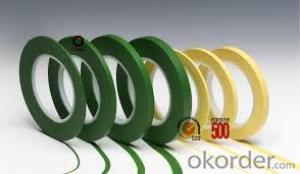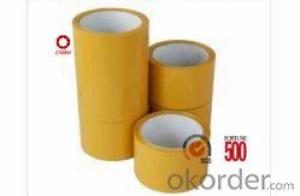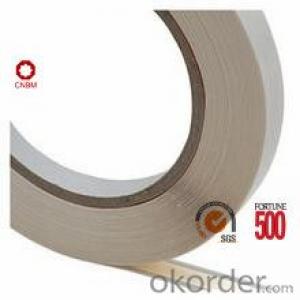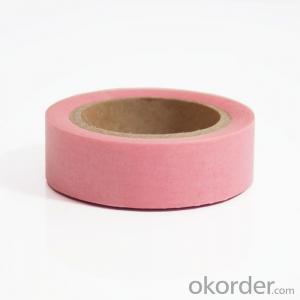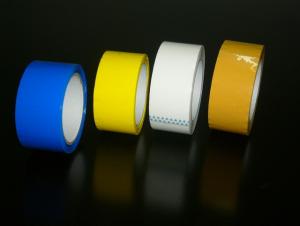Discount Packaging Tape for Plastic Film Masking in Auto Industry
- Loading Port:
- Qingdao
- Payment Terms:
- TT OR LC
- Min Order Qty:
- 1000 roll
- Supply Capability:
- 30000 roll/month
OKorder Service Pledge
OKorder Financial Service
You Might Also Like
Specification
Plastic Film For Masking In Auto Industry
1. Structure of Masking Film Description
Masking Film is of HDPE film and masking tape. A convenient, pretaped plastic film which unfolds to cover and protect various surfaces while painting. Specially treated film clings to surfaces and is easy to clean up.
2. Main Features of Masking Film
Multi-Folded easy to use;
Strong and Flexible;
Competitive price
Indoor/outdoor painting
Sunlight stable even on glass
3. Masking Film Images


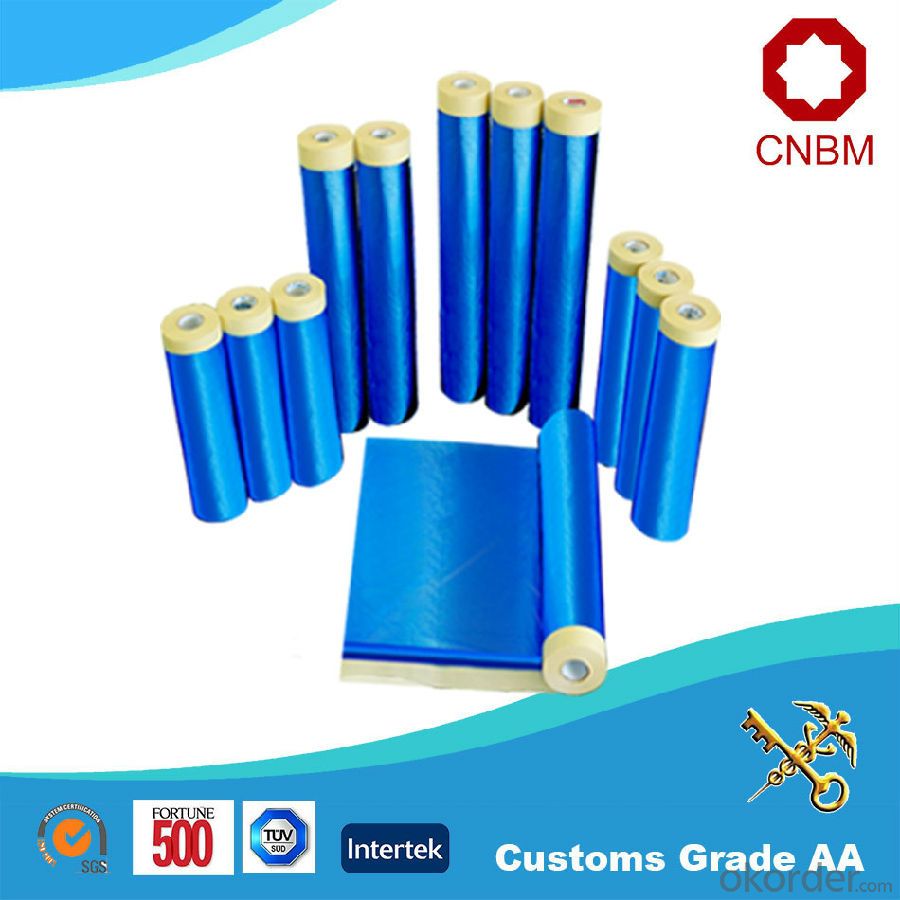
4. Masking Film Specification
Tape Size | Rolls/Carton | Weight/Roll(kg) | Jointing Material | Temperature Resistance |
330mm*30M | 20 | 0.12 | Crepe parer | -5—60°C |
550mm*30M | 50 | 0.17 | Crepe parer | -5—60°C |
1100mm*30M | 25 | 0.30 | Crepe parer | -5—60°C |
1400mm*30M | 10 | 0.39 | Crepe parer | -5—60°C |



5. FAQ
Q1. How to guarantee the quality of the products?
We have established the international advanced quality management system,every link from raw material to final product we have strict quality test;We resolutely put an end to unqualified products flowing into the market. At the same time, we will provide necessary follow-up service assurance.
Q2.Why choose us?
20 Years Experience USD1.6 billion yearly sales
World Top 500 Enterprise
OEM service, supported by strong R&D team
A short lead time
Quality guarantee with third party certification
One-step service: transportation, capital etc.
Q3. How long can we receive the product after purchase?
In the purchase of product within three working days, We will arrange the factory delivery as soon as possible. The pecific time of receiving is related to the state and position of customers.Commonly 7 to 10 working days can be served.
- Q: Is packaging tape safe to use on mirrors?
- Yes, packaging tape is generally safe to use on mirrors. It is a strong and adhesive tape that is designed to securely hold items together. However, it is important to note that the type of packaging tape used can affect its safety for use on mirrors. Clear packaging tapes or tapes specifically designed for glass surfaces are typically the best options to avoid any potential damage or residue left on the mirror. Additionally, it is recommended to test a small, inconspicuous area of the mirror before applying the tape to ensure it adheres well and does not cause any damage.
- Q: Can packaging tape be used for sealing packages with delicate fabrics or clothing?
- Yes, packaging tape can be used for sealing packages with delicate fabrics or clothing. However, extra care should be taken to prevent any damage to the fabric. It is recommended to use a gentle touch while sealing the package and consider adding an additional layer of protective material, such as tissue paper or bubble wrap, to provide cushioning and prevent any potential damage.
- Q: Can packaging tape be used for outdoor applications?
- Yes, packaging tape can be used for outdoor applications. However, it is important to note that not all packaging tapes are designed for outdoor use. Regular packaging tapes may not withstand extreme weather conditions or exposure to UV rays, which can cause them to deteriorate or lose their adhesive properties. To ensure the durability and effectiveness of packaging tape for outdoor applications, it is recommended to use specialized outdoor or weather-resistant packaging tapes. These tapes are designed with stronger adhesives and materials that can withstand outdoor elements such as rain, heat, cold, and sunlight. They are often made with materials like acrylic or rubber, which provide better resistance to moisture, temperature changes, and UV rays. When selecting packaging tape for outdoor applications, it is important to consider the specific requirements of the intended use. This may include factors such as the duration of exposure to outdoor conditions, the weight and size of the package, and the surface to which the tape will be applied. By choosing the appropriate outdoor packaging tape, you can ensure that your packages remain securely sealed and protected, even in outdoor environments.
- Q: Can packaging tape be used for sealing ceramic items?
- Yes, packaging tape can be used for sealing ceramic items. Packaging tape is designed to be strong and durable, making it suitable for securing and sealing various materials, including ceramics. However, it is important to note that packaging tape may not provide the same level of protection as specialized ceramic sealants or adhesives. If you are looking for a more secure and long-lasting seal, it is recommended to use a ceramic-specific adhesive or sealant that is designed to withstand the unique properties of ceramics, such as temperature changes or moisture exposure.
- Q: Can packaging tape be used for sealing chemical or hazardous material containers?
- Sealing chemical or hazardous material containers with packaging tape is not advised due to its lack of necessary properties for effective containment and prevention of leakage. These substances often necessitate specialized containers and sealing methods to ensure safety and compliance with regulations. These specialized containers are engineered to withstand the corrosive or reactive nature of the substances they hold, with seals designed to provide a secure and leak-proof closure. In contrast, using packaging tape can be risky as it may result in leakage, contamination, and exposure to harmful substances. It cannot reliably serve as a barrier against leaks or spills, potentially leading to accidents, injuries, or environmental harm. To properly seal chemical or hazardous material containers, it is recommended to use specific sealing materials that are specifically designed for this purpose. This may involve utilizing specialized caps, gaskets, or seals that are compatible with the specific substance being contained. Moreover, it is crucial to adhere to the guidelines and regulations provided by relevant authorities to ensure the safe handling, storage, and transportation of these materials.
- Q: I want to be involved in the tape industry, is the parent type their split, but do not know the parent roll cut in segmentation machine is good, or even after the parent roll processing, and also is the problem of the equipment, how much money, thank you
- Also known as sealing tape, packing tape, which is based on BOPP biaxially oriented polypropylene film as substrate, after heating evenly pressure-sensitive emulsion, the formation of 8 mu m----28 Mu ranging from m layer, light industry enterprises, companies and individuals are indispensable in life activities,
- Q: How do I choose the right packaging tape for my needs?
- Choosing the right packaging tape for your needs can be an important decision to ensure your packages are securely sealed during transit. Here are a few factors to consider when selecting the appropriate packaging tape: 1. Strength and durability: Consider the weight and nature of your packages. If you are shipping heavy or bulky items, opt for a tape that offers high tensile strength and can withstand rough handling. Look for tapes made from materials like fiberglass or reinforced with polyester fibers. 2. Adhesive type: Different packaging tapes use various types of adhesives. Acrylic adhesive is common and offers a good balance of performance and affordability. For more challenging surfaces or extreme conditions, consider hot melt adhesive, which provides superior bonding strength. Additionally, water-activated tape, also known as gummed paper tape, is a great option for added security as it forms a permanent bond when moistened. 3. Width and length: Determine the appropriate width and length of tape based on the size of your packages. Thicker tapes are generally more durable, while longer rolls may be more cost-effective for high-volume packaging. 4. Transparency and aesthetics: If you require your packages to have a professional appearance or if you need to see the contents of the package easily, opt for a clear or transparent packaging tape. However, if appearance is not a concern, choosing a colored tape can help with easy identification or branding purposes. 5. Environmental considerations: If you are conscious of your carbon footprint, look for packaging tapes made from eco-friendly materials or those that are recyclable. Some tapes are also water-based, solvent-free, or made from renewable resources, making them a greener choice. 6. Dispenser compatibility: Consider the type of tape dispenser you have or plan to use. Make sure the tape you choose is compatible with your dispenser, as some tapes require specific types of dispensers. 7. Cost: Finally, compare prices and consider your budget. However, keep in mind that sacrificing quality for a lower price may result in inadequate tape performance and potential package damage. By considering these factors, you can make an informed decision and choose the right packaging tape that best suits your needs, ensuring your packages arrive securely and intact.
- Q: What are the considerations for using packaging tape on temperature-sensitive items?
- When using packaging tape on temperature-sensitive items, there are several considerations to keep in mind. Firstly, it is important to choose the right type of packaging tape. There are temperature-resistant tapes available specifically designed to withstand extreme temperatures. These tapes are usually made with materials that can withstand high or low temperatures without losing their adhesive properties or deforming. It is crucial to select a tape that is suitable for the temperature range the item will be exposed to during storage, transportation, or any other handling processes. Secondly, it is important to properly store the packaging tape. Extreme temperatures can affect the adhesive properties of tape, causing it to become less effective. It is advisable to store the tape in a climate-controlled environment, away from direct sunlight or areas with excessive heat or cold. This will help maintain the adhesive strength and overall quality of the tape. Additionally, when applying packaging tape to temperature-sensitive items, it is important to ensure that the surface is clean and dry. Any moisture or dust particles on the surface can compromise the adhesion of the tape and lead to inadequate sealing. Properly preparing the surface will help ensure a secure and reliable bond between the tape and the item. Furthermore, it is essential to consider the duration of exposure to extreme temperatures. If the item will be exposed to high or low temperatures for an extended period, it may be necessary to use additional protective measures such as insulation or specialized packaging materials to provide extra insulation. Lastly, it is important to test the tape's performance before using it on temperature-sensitive items. Conducting a small-scale trial or using a sample item can help determine if the tape is suitable for the specific temperature conditions. This will help identify any potential issues or limitations before using the tape on valuable or delicate items. In conclusion, when using packaging tape on temperature-sensitive items, it is crucial to select the appropriate tape, store it properly, prepare the surface adequately, consider the duration of temperature exposure, and test the tape's performance. By considering these factors, one can ensure the safe and secure packaging of temperature-sensitive items.
- Q: Can packaging tape be used for sealing envelopes?
- Indeed, sealing envelopes can be accomplished with packaging tape. While its primary purpose is to securely seal boxes and packages, packaging tape can also effectively seal envelopes. Its formidable adhesive properties guarantee a sealed envelope throughout its journey. Nonetheless, it is worth mentioning that packaging tape may not be the most visually appealing option for sealing envelopes, as it tends to be wider and less transparent compared to conventional choices like glue sticks or clear tape.
- Q: Can packaging tape be used for sealing packages for shipping?
- Yes, packaging tape can be used for sealing packages for shipping. Packaging tape is specifically designed to securely seal packages and keep them intact during transit. It provides a strong and durable bond that can withstand the rigors of shipping and handling. Whether you are shipping small or large packages, packaging tape is an essential tool to ensure that your items are properly sealed and protected during transportation.
Send your message to us
Discount Packaging Tape for Plastic Film Masking in Auto Industry
- Loading Port:
- Qingdao
- Payment Terms:
- TT OR LC
- Min Order Qty:
- 1000 roll
- Supply Capability:
- 30000 roll/month
OKorder Service Pledge
OKorder Financial Service
Similar products
Hot products
Hot Searches
Related keywords














